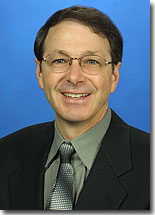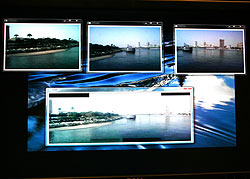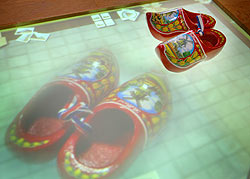REDMOND, Wash. — Feb. 24, 2009 — While the core mission of Microsoft Research is to advance the state of the art in computer science, it’s no surprise that nearly every year nascent technologies from the company’s research division make their way into new products.

Microsoft Senior Vice President Rick Rashid leads Microsoft Research.
Many of those connections begin with the company’s annual innovation fair, Microsoft ResearhTechFest, which is taking place this week on the Redmond, Wash. campus. Launched in 2001 as a way to connect Microsoft Research’s body of work to the company’s product development teams, TechFest has become a widely anticipated event, open to the media and attended by more than 6,000 Microsoft employees each year.
Technologies shown at TechFest have found their way into Live Search, Visual Studio, Microsoft Office, digital media technologies and other products. Early 1990s research into 3-D graphics and computer vision, which continues today, is increasingly being used in products from Xbox to Windows, along with new software for managing digital images, processing video and audio, teleconferencing in new ways and more. The entire digital media division at Microsoft has its roots in early Microsoft Research efforts to develop streaming video technologies.
The man in charge of innovation at Microsoft is Senior Vice President Rick Rashid. As head of Microsoft Research, Rashid is responsible for many of the technologies Microsoft has built its business on over the past two decades. Rashid was so impressed with the results of the first TechFest that he and his staff made it an annual priority thereafter.
“There have been a number of technology transfers where someone who might not have thought about using a particular technology would see what we’re doing, and it would change the course of a product or allow us to move in a particular direction,” says Rashid. “It became clear after our first event that this was good for both employees and researchers, and it has a real value in being able to realize the potential of the technologies we’re developing.”
The Journey of Basic Research
If Microsoft CEO Steve Ballmer’s Feb. 6 address to Congress wasn’t intended as a curtain-raiser for TechFest, it could have been. In examining current economic conditions, Ballmer pointed to a possible salvation, a staple of American economic success since World War II, and the founding pillar of his own company: innovation.

The ubiquity of mobile phones in today’s society enables capturing multiple videos of the same event, each with a small field of view. This Microsoft Research technology enables those small videos to be “stitched” together into one higher-resolution video in real time. Redmond, Wash. Feb. 24, 2009.
“America really has to return to growth that’s built on innovation and productivity, rather than leverage and private debt,” Ballmer said. “We need to renew our innovation capacity.”
At Microsoft, that capacity has been in a constant state of renewal since Rashid founded Microsoft Research nearly two decades ago, and much of the activity falls under what is known as “basic research” — exploration that is undertaken not with any specific product or goal in mind, but because the subject of the research is inherently interesting or valuable.
“In the early 1990s, there was no product activity focused around streaming media and graphics, but we thought these were important areas in computer science,” Rashid says.
Microsoft’s general investment into graphics 15 years ago, sustained to this day, led to a broad portfolio of new products and services. Each new breakthrough over that period, says Rashid, was a “signpost on the road,” but like the proverbial Zen traveler, the journey is undertaken for its own sake, with the destination being more of a milestone than an accomplishment.
“The core goal of Microsoft Research is to advance the state of the art, but a lot of what makes Microsoft the company it is today is the result of having a basic research group for more than 17 years,” says Rashid. “A lot of the technologies that the company uses, in the digital media area, the natural language and speech technologies, the original technologies that went into SQL for data mining, the early work that led to the creation of Windows Mobile, the early work that the company did in ecommerce — these were all consequences of having a basic research group and the activities that we have going on.”
Signposts Signal Larger Shifts
A recent example is Microsoft Surface. Surface made its debut at TechFest a number of years ago and is now making its way into the market, both on its own and through product features such as the multitouch capabilities being developed for Windows.
Surface may seem like an end in itself, but Rashid says the emergence of Surface is another signpost pointing to overall progress in the field of user interfaces. Whether through touch technology or voice response systems such as that in the Ford Sync, people are increasingly using gestures and voice to control computing systems.
“People always ask, ‘When will we get natural user interfaces?’” Rashid says. “We’re already doing it. It’s a natural change that’s happening, and it’s the result of a lot of research over a considerable period of time.”
TechFest 2009 features a similar collection of smaller technologies that can make a big difference when added to the general mix of Microsoft software.
One example is new work in audio spatialization and automatic echo-cancellation, signal processing technologies that will change the experience of teleconferencing.

Microsoft Researchers in Cambridge, England, are working on a range of technologies and services called The Timecard Project. The technologies allow families to communicate in new, flexible ways and to organize and store digital “artifacts” that can tell the family’s story. Redmond, Wash. Feb. 24, 2009.
“Audio spatialization uses speakers to create the illusion that call attendees have different locations spatially,” says Microsoft researcher Zhengyou Zhang. “This allows you to use the audio sense you already have, that you normally use in conversation, to isolate who you’re talking to, and to associate a location in space with a particular individual. Ultimately this leads to a more enjoyable conversation.”
Zhang and his team have also tackled the well-known echo problem inherent in teleconferences through a new echo-cancellation technology.
“In a conference where there are multiple voices coming out of multiple speakers, it becomes important to eliminate the echoes that might naturally occur,” Zhang says. “So it all helps create a natural environment for holding a conference.”
Another technology on display this year comes from the Cairo Microsoft Innovation Center, where technology is being developed to automatically “stitch” video together from mobile phones or other sources. It’s an extension of technologies used to create the recently released Photosynth product.
“With the kind of mobile video that most people have, you never get too see very much,” says researcher Ayman Kaheel. “We aim to enable multiple mobile phones to collaborate in recording an event and then, in real time or near-real time, construct one higher-resolution video from the resulting video streams.”
With the ability to be used in near-real time, Kaheel’s technology can supplement Web services that allow live streaming of videos from mobile devices for instant viewing.
“Imagine that you have a concert, and people attending can send live video streams capturing the concert from different viewpoints,” he says. “Now the Web service users can view one video stream that provides a panoramic view of the concert.”
If stitching together mobile video has broad implications, how about stitching together memories? A team of researchers from Cambridge, England, is working on a range of technologies and services that allow families to communicate in new, flexible ways, and to organize and store digital “artifacts” that can tell the family’s story, potentially even to later generations.
“The Timecard project considers how digital media can support our experience of the past,” says researcher Richard Harper. “It also provocatively aims to consider the development of technologies that are not built for planned obsolescence, but are built specifically to last and to outlive their owners. Timecard is a device and a service that can create timeline style records of a person, similar to a ‘baby book,’ but extending throughout life.”
In a familiar theme, Timecard is part of a larger body of research into how families can connect and share information. Harper and his team have come up with a half-dozen new technologies on display at TechFest this week, all designed to explore the digital side of family.
“We’re using 3-D modeling, devices, display technologies that take advantage of multitouch, and lessons we’ve learned in studying how families work,” Harper says.
The Road From Cairo
According to Rashid, the mere fact that he can mention research coming from Cairo, Cambridge and other areas of the globe reflects another evolution he’s seen at TechFest through the years.
The organization he founded as a single person nearly 20 years ago has grown to represent more than 800 Ph.D.s and hundreds of support staff in locations around the world: Redmond; Silicon Valley, Calif.; Cambridge, Mass.; Beijing, China; Cambridge, England; and Bangalore, India.
“When we started TechFest we basically just had a research lab here in Redmond,” Rashid says. “One of the real benefits of TechFest today is the opportunity to bring our researchers from all over the world to interact with our teams here and share the technologies they are developing.”
The international flavor of Microsoft Research today has added new perspectives and allowed the organization to tap into research talent around the world, but even with TechFest becoming such a melting pot, the core mission of Microsoft Research remains the same around the globe: continued investment to advance the state of the art in technology.
According to Rashid, that commitment is a big part of how Microsoft has remained successful as an innovation company 30 years after its original entry into the commercial market. And, like Ballmer, he believes it is more important today than ever, given current conditions around the world.
“You want to be prepared for change and you want to be a catalyst for change, but you don’t know what the future holds,” asks Rashid, “how will we get out of an economic downturn? By creating new products, by generating new ideas, by taking advantage of opportunities that people may have not been expecting. We may not know what’s down the road, but looking at the work on display here this week, it’s clear we’re getting there.”




